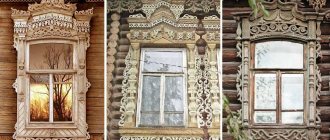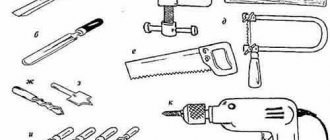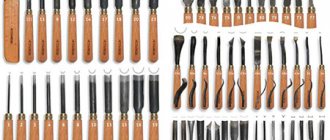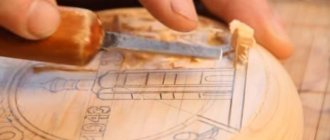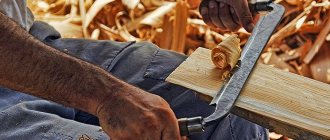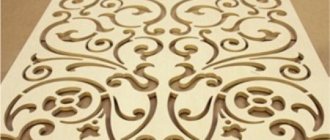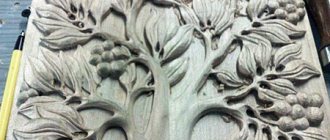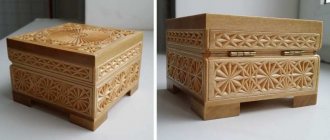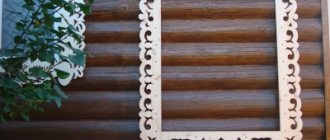One of the most striking folk crafts is house carving, a characteristic feature of facades in ethnic style. The front part of the house is decorated with combinations of plant and geometric patterns, animal figures, and intricate plots. The artistic composition is applied to a wooden surface using a special carpentry tool. Thread elements are usually removable. After applying the image, the carved parts are applied to the platbands and roofing blades. The exception is columns and house doors, when the carving is applied directly to part of the building.
Types of wood used
The choice of wood species suitable for making house carvings yourself is large. Wood is the most commonly used material among folk craftsmen. The most popular species are linden, oak, birch, walnut, pear, and alder. They have the following qualities:
- Linden wood blanks are great for small carved decorative elements. Wood has a soft structure, so it is not suitable for large-sized parts of home decoration. But thanks to its flexibility, it serves as an excellent material for beginners in carpentry.
- Oak elements are used if you want to create an artistic composition that can be stored outdoors for many years. The strength of wood allows you to create massive decorative elements without the risk of deformation or cracking.
- Birch overlays are distinguished by their clear lines. As a rule, small compositions are made from this type of wood, which are then assembled into one whole.
- Walnut is not used in overhead lightweight openwork elements. Wood is too heavy for this. Due to its spectacular appearance after polishing, walnut is used when it comes to massive elements - columns, doors, gates.
- Pear is considered a universal wood species due to its resistance to deformation and cracking. Pear blanks are easily carved with an abundance of small details.
- Alder is not often seen in building decor, as it is used as a base for carved furniture. This is due to the ability to imitate valuable wood species using alder.
Coniferous wood is not easy to use to decorate your home with home carvings. They are fibrous and prone to cracking, but are also popular due to their low cost and pliability. With a competent approach to wood processing, house carvings made of coniferous wood can remain intact for years.
↑ Faces along the road
How
much travel attracts us. How I want to get away from the bustle of the city. The further away the place, the more mysterious and attractive it is. Wildernesses and abandoned villages attract with old dilapidated temples and ancient stone slabs. Touching the history of our distant ancestors...
But it’s not always possible to take off and go to distant forests. Often you just need to go to the country, urgently dig up the beds, take parents and children with a lot of bulky things, and so on and so forth. And it seems that another weekend is lost for mysterious trips. What a pity...
But in reality this is not so, you just need to be able to look around. Not so much to look as to see. And then the familiar road, familiar and well-trodden, as if through a peephole in the door, will reveal incredible treasures, a huge layer of the ancient culture and history of our distant ancestors. This is exactly what happened to me when one day, in the usual picture, an amazing discovery appeared, taking me on an interesting journey.
Driving along the houses lined up along the road, you involuntarily look closely and, in order not to get bored, look for distinctive features in them. Here they made the now fashionable siding and covered the old logs under faceless plastic. Here is a new brick house behind a high fence. Here is another one, richer, with forged bars on the windows. But all this is an ordinary, faceless landscape. And then the gaze stops at the old hut, which looks somewhat shabby against the background of the neighboring stone houses. And there is something in her that makes you stop, something meaningful, as if you see a face, alive and expressive.
Platband. Dmitrova Mountain. A house with figured banks and a svetelka. (photo: Elena Filippova) The platbands on the windows
are what caught my eye. Carved, in different colors, with simple and intricate patterns. And no matter what condition the house is in, you often see that its owner takes care of the platbands first of all. Look, the hut is askew, but the trim is freshly painted! The platbands on the window are like the face of the house, its calling card. They make every home different from its neighbors.
What made the Russian peasant in the old days, driven by a difficult life into the utilitarianism of his existence, pay such reverent attention to such impractical details as carvings on the house and platbands in particular?
↑ LIVING TREE
From time immemorial, wood has played a huge role in the life of Russian people. Numerous beliefs associated with the tree have deep roots. The familiar birch tree, which is unofficially considered a symbol of Russia, was once the totem tree of the Eastern Slavs. Is it not from there that we got the memory of our sacred tree and such an incomprehensible love for it?
It was believed that the tree retained its magical powers during any processing and could transfer them to master carpenters. Carpenters had their own beliefs and signs, which came down to us in folk tales and village stories. Each tree had its own power, and not every tree could be used to build a house. For example, it was impossible to take trees growing at intersections and on abandoned old roads to build houses.
View of the Medvedeva Pustyn from the Tver coast.
The symbol of the tree, initially completely pagan, organically fit into the system of Christian ideas about the world. Whole groves and individual trees could be sacred—miraculous icons were found on such trees.
Belief in the sacred power of wood has not disappeared over time; it has changed, interwoven into human consciousness, and has come to us in the form of house carvings. The platband on the window in a Russian hut is materialized magical spells, rooted in ancient times. Will we be able to understand the meaning of these spells?
↑ MYSTERIOUS PATTERNS
Listen to this word: “platband” - “located on the face.” The facade of a house is its face facing the outside world. The face should be washed and beautiful. But the outside world is not always kind and, sometimes, you need to protect yourself from it. Doors and windows are not only a way out, they are an opportunity to get inside. Each owner tried to protect his home, provide his family with food and warmth, safety and health. How could he do this? One way to protect yourself is to surround yourself with protective signs and spells. And the platbands not only closed the cracks in the window opening from drafts and cold, they protected the house from evil spirits.
Despite the huge variety of house carving patterns, certain repeating images stand out. The most interesting thing is that these same images can be found in Russian folk embroidery. Towels and shirts prepared for the birth of a child, a wedding or a funeral were of great importance to our ancestors and were part of the rituals. In order for the child to be healthy, the family to be strong and rich, and the woman to be fertile, it was necessary to protect them with magical spells. It is these spells that are depicted in the embroiderers’ patterns.
Cockerels on the pediment (photo: Filippova Elena)
But if this is so, does it mean that the patterns on the platbands carry the same magical power?
The paganism of the Russian village, closely intertwined with Orthodox Christianity, was not a consequence of the darkness and lack of education of the Russian peasant. It’s just that, unlike a city dweller, he lived so closely with the nature around him that he had to learn to negotiate with it. It is naive to blame the peasants for leaving Orthodoxy. Some people have preserved it to a greater extent. On the contrary, it is we, the city dwellers, who have lost that important archaic connection with Mother Nature, on which all life outside the city is built.
↑ BEREGINYA AND GROUNDWATER
What was one of the most important events in the life of our ancient ancestors? Probably birth. And the woman-mother had to become the main figure.
A figurine with outstretched arms and legs is a figurine of a woman giving life, personifying the feminine principle, one of the most common images that occupy an important place, both on old embroideries and on carved frames. One of her names is bereginya.
It is very interesting to look for figures of beregins in carved patterns: sometimes it is defined very clearly, and sometimes it is so distorted that it looks like an amazing interweaving of flowers and snakes. But in any case, it can be recognized - the central symmetry of the figure, the head, outstretched arms and legs.
Stylized figures of beregins, different variations of the same theme.
Another important symbol of the magical signs of our ancestors is the sun. The solar circle was depicted in different forms; you can find the sunrise and sunset. All signs related to the course of the sun, to its position in the sky, are called solar and are considered very strong, masculine signs.
Rising and setting sun (photo: Elena Filippova)
Without water there is no life; the harvest and, as a consequence, the life and well-being of the family depend on it.
There are heavenly and underground waters. And all these signs are on the platbands. Wave-like patterns in the upper and lower parts of the casing, running streams along its side shelves - these are all signs of water, which gives life to all life on earth. The land itself, which gives people a harvest, is not left without attention. The signs of agricultural magic are perhaps the simplest, one of the most widespread. Diamonds with dots inside, intersecting double stripes - this is how our ancestors painted a plowed and sown field.
Platband.
The city of Konakovo, Tver region. Snake pattern. The house was transported from the city of Korcheva in 1936 (photo: Elena Filippova) And how many animal motifs can be found on our windows! Horses and birds, snakes and dragons take your breath away. Each image had its own meaning in the magical world of the ancient Slavs. A special place in animal motifs is occupied by snakes, which are closely associated with the concept of water, and therefore fertility. The cult of guardian snakes, lord snakes, has deep roots and deserves a separate story.
Miracle Yudo (photo: Filippova Elena)
All these patterns and images once had a certain meaning, being essentially security signs. They decorate ancient ritual objects, and they also appear on the platbands. Folk tradition has carried these signs through the centuries. But over time, they lost their magical meaning for us and their essence was forgotten. Ancient archaic patterns have turned into decorative elements, diluted with modern ornaments that are not related to their past meaning. It is almost impossible to read these ornaments, understand their deep meaning and unravel magic spells. That is why they are so attractive...
↑ ANGEL WINDOWS
According to some Russian folk legends, an Angel gave a window to a man. Here is how it was.
The first houses that people built were without windows. One woman, in order to illuminate her house, began to run with a sieve from the yard into the house, hoping to bring sunlight in the sieve. Then an angel appeared to her and said: “What a bad woman!”, took an ax and cut a window in the wall.
The woman replied: “This is all good, but now it will be cold in my house.” The angel went to the river, caught a fish and covered the window opening with a bubble. The hut became light and warm. Since then, people have been building their houses with windows.
When I first met this beautiful legend, I had a strange question: how many fish did it take to cover one window with their bubbles?
But it turned out that the windows in huts we are accustomed to appeared relatively recently, only in the 18th century. And then, at first there was only one such window in the house, it was called red. The red window had glass installed and had a frame and shutters.
What then did the angel cut through?
The very first windows were very simple and small in size; they were called fiber windows. Such a window was cut through two adjacent logs and closed from the inside with a latch board. The window was small; to open it, you had to move the bolt. It is believed that the name “drag window” comes from the word “drag.”
Volokovoe window in the Istra Museum of Wooden Architecture. (photo: Filippova Elena)
Beginning in the 19th century, when glass production became widespread in Russia, red windows everywhere replaced the ancient fiberglass windows.
But even now they can be found in villages, on outbuildings, in barns and farmyards. Take a closer look, and suddenly you will find an angel's window where you didn't expect it.
But how can this be? If red windows appeared only in the 18th century, then how could archaic magical signs get on the platbands? So all our conclusions collapse so easily?
But nothing like that. The ancient traditions preserved in house carvings were transferred to the frames of the red windows. Valances on the roofs of houses, piers (boards along the edges of the hut), they all bore and now bear the same signs that we read on the platbands. And who said that the portico windows were not protected from evil spirits?
For example, in Kizhi, at least one very, very old fiberglass window, decorated with a carved solar disk, has been preserved. The casing on the portico window is also in the Nizhny Novgorod Museum-Reserve of Wooden Architecture.
Museum of Wooden Architecture on the Shchelokovsky Farm in Nizhny Novgorod. Pashkova's house, mid-19th century. (photo. Bobylkova Irina)
Wooden utensils, spinning wheels, carved ladles and combs are carefully preserved in museums. And there are practically no carved platbands. Single and not very old copies are the maximum that can be found.
Why?
The answer is surprisingly simple. When people moved from house to house, they took their great-grandmother's spinning wheel with them, but did not take the trim from the windows. When it was necessary to save the house from a fire, no one tore off the old boards. And the carved frames with magical symbols died along with the house. That is life. The situation changed no more than two hundred years ago, with the advent of the first collectors of antiquities and museum creators.
↑ PETER I AND THE AX
In the old days, Russian carpenters did not build houses, but cut them. It is this term that is found in archival documents and ancient chronicles. They chopped down huts, temples and entire cities, skillfully using an ax for this. A tool such as a saw came to Russia from Europe only in the 18th century under Peter I.
However, this does not mean at all that Russian men were so dark. In some ways, they had no equal in carpentry. The fact is that when cutting a tree with an ax, its fibers seem to crumple, closing the pores from moisture that is destructive to a wooden structure. And when processed with a saw, the fibers, on the contrary, are torn and easily allow moisture to pass into the wood.
But under Peter I a different task arose - to build very quickly. This problem could not be solved with an axe.
The vast majority of current house carvings are made using the sawing technique, which appeared along with the new tool. The new technique introduced great variety into old patterns, intertwining and modifying them. Starting from the 18th century, old magical signs began to be overgrown with new ornaments. Entire teams of master carpenters traveled around Russia, erecting houses decorated with platbands, transferring their style from village to village. Over time, entire albums of wood carving patterns began to be published.
Street in Kushalino. Houses with carved platbands. (photo: Filippova Elena)
Of course, carvers did not specifically cut out solar patterns or beregins, either in the 19th century or a century earlier. By the way, the embroiderers did not embroider any magical signs. They did as their great-grandfathers and great-grandmothers did, as was customary in their family, in their village. They did not think about the magical properties of their patterns, but carefully carried this knowledge, which they received as an inheritance, further in time. This is what is called the memory of ancestors.
These are the mysterious distances you can wander into without leaving for distant lands. It is enough to take a different look at the usual road. And these are not her only miracles; is there something else waiting for us around the corner?
Filippova Elena
Types of techniques
The main feature of wood carving on platbands, roofs, and facades of houses is the frequent repetition of the storyline and ornaments on different parts of the building. There are several techniques used to decorate houses with carvings. The most common methods are:
- The blind relief technique involves applying a pattern in the form of a non-through relief on a uniform background surface. Images of mythological creatures, plot paintings, and floral ornaments using this technique can be found on pediments, gates, and platbands.
- Flat-relief carving is characterized by knocking out the background, not the design - it remains flat.
- Openwork carving consists of applying a through ornament to the workpiece, which is typical for overlay elements. House wood carving as a result looks like weightless lace.
- The contour technique is great for beginners due to its ease of execution. The drawing is simply outlined with a line with a recess. In this technique, as a rule, complex motives are not performed.
Types of carvings for decorating a country house
Carvings for wooden buildings are found in the following varieties:
- Blind thread. This carving has another name - ship carving. Wooden patterns are made directly on logs or bars. The blind type of carving for houses is used very rarely in our time. After all, a log means an area of several tens of square meters.
The pattern is made with blind carving.
Therefore, manual processing takes quite a lot of time, and it is impossible to do without special skills. The work of a true master is expensive. And there are practically no such folk craftsmen left. - Openwork carving. This is a through thread that will require a jigsaw. Each carved part for the house is first made in the workshop. The finished elements are simply placed on the façade and secured. Wooden patterns made using this type of carving seem light and almost weightless. Such overlays do not burden the structure of the house.
Carved patterns serve as beautiful decorations. The most common options include geometric patterns and carvings with plant motifs.
Experienced craftsmen will be able to make statues or figures of animals, as well as depict scenes.
Preparing for work
Before starting any woodworking, you must study the safety rules. The protection of life and health is based on them. For carpentry they are:
- Work is carried out either in the fresh air or in a room with good ventilation.
- A prerequisite is the presence of protective gloves. The respiratory organs are protected from dust with a respirator; when working with the tool, goggles are worn to protect the visual organs from foreign bodies.
- The room should be well lit; it is better to work during daylight hours.
Sawing and cutting process
A not very intricate design will reduce the amount of work.
The main emphasis is on removing wood with feather drills and cutting out the outer contour of the image with a saw.
Also, use the drill bit as much as possible to remove wood from the inner contour. Remove the remaining wood with a narrow hacksaw, trimming the contour.
Please note that cutting with a feather drill should be done on both sides. To do this, drill a small hole in the center of the outline.
Use a fine-tooth saw. This will avoid “torn” wood along the contour of the cut.
In general, to avoid chipping wood, first drill holes and then use a saw
Additional protection of the ends from getting wet and will emphasize the visual effect of removing the edge with a knife along the entire contour of the thread.
To clean the entire surface from roughness, use a knife, chisels and sandpaper.
Subscribe to our Yandex.Zen channel
Sketching
All parts of the house on which decorative elements will be located must be carefully measured. If artistic skills allow, you can draw a preliminary design of a decorated house, observing the proportions . After this, you can start purchasing wood for work: it is better if it is purchased from a warehouse, dry - then it will not need to be “matured” first. The wood is selected without visible defects. For overhead elements, the thickness of the board should be about 2.5 cm. Next, you can begin to develop detailed sketches of decorative elements.\
Craftsmen who do not have artistic talent are advised to find ready-made templates in specialized literature - they can easily be copied onto paper at the required scale. Sketches of wood carvings with a house pattern can be easily developed in any of the graphics utilities. The sketch is drawn manually in full scale on specially lined paper with a pencil or a pen with a special nib - this can be purchased at art supply stores.
Secrets of making your own platbands
Mastering the art of carving requires more than just patience and time. Before starting work, prepare the necessary tools:
- chisels - flat, round, semicircular, angular, caesars, cranberries;
- tenoning tool;
- knife-cutter;
- knife-jamb.
Each of the tools has its own purpose. Using chisels, the master easily removes the layer of wood on top. This tool is used to make grooves or holes. The chisel has a shank and a pointed cutting part. During the carving process, the craftsman holds the handle. You can also use a mallet.
A tenoning tool is a multifunctional device that allows you to produce tenons and lugs with high precision. The cut out elements do not require further adjustment.
Options for patterns of carved platbands
Knives are essential tools. Many craftsmen make the popular cutting knife themselves. The tool has a number of advantages:
- light weight;
- simple design;
- ability to perform many functions.
Installation of decorative elements
Before installation, carved elements are painted and covered with a layer of varnish to prevent premature destruction of the composition. The easiest way to attach a part is to nail it with an ordinary nail . The hats must be camouflaged by painting them to match the wood. Carved elements attached with dowels look more aesthetically pleasing. They are not visible from the outside, but the strength of such fastening is high.
Despite the fact that the construction market is flooded with a variety of wood adhesives for external work, it is not recommended to use them. There are no guarantees that the adhesive mixture will provide sufficient strength. Do not forget about the two golden rules of successful decoration with carvings: the principle of specularity must be observed in the ornaments; before final installation, it is extremely important to check the symmetry of the attached parts.
Mastering the craft requires scrupulousness, balance, thoroughness, and leisurely execution of work. The result of the efforts of the master of home wood carving with his own hands is not only beautiful from an artistic point of view, but also large-scale. Any mistake in work can cost many weeks of work; sometimes mistakes cannot be corrected.
Originally posted 2018-08-29 11:36:25.
How to master the art of Nizhny Novgorod master carvers
Beginners should always remember the features of house carvings typical of the Nizhny Novgorod region:
- non-cut background;
- the pattern is flush with the wood material.
Various geometric shapes are widely used here: circles, triangles, quadrangles and others. Blind carving allows the carver to experiment on wooden walls and create large-scale images. Any fantasies can be realized. Today, carved paintings are created in different styles.
It is recommended that a novice craftsman first try to fashion the desired ornament from clay or plasticine. This training exercise helps develop the right sense of scale.
Carved ornament option for home decoration
After such practical training, the beginner will gain confidence, which will help him work with wood. You can start cutting out facades once the necessary skills have been acquired. Make household items that will definitely be useful around the house. Craftsmen who want to make complex or multi-layer platbands use stencils.

